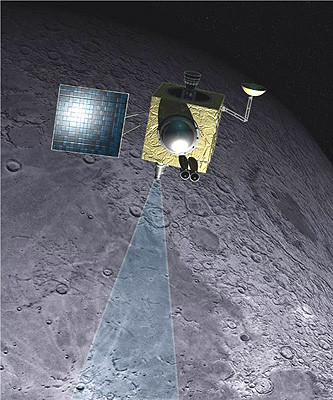NASA-funded lunar research has yielded evidence of water locked in mineral grains on the surface of the moon from an unknown source deep beneath the surface.

Chandrayaan-1 is an Indian Space Research Organization (ISRO) mission designed to orbit the moon over a two year period with the objectives of upgrading and testing India’s technological capabilities in space and returning scientific information on the lunar surface. Image credit: Indian Space Research Organization.
Using data from NASA’s Moon Mineralogy Mapper (M3) instrument aboard the Indian Space Research Organization’s Chandrayaan-1 spacecraft, scientists remotely detected magmatic water, or water that originates from deep within the moon’s interior, on the surface of the moon.
The findings, published Aug. 25 in Nature Geoscience, represent the first detection of this form of water from lunar orbit. Earlier studies had shown the existence of magmatic water in lunar samples returned during the Apollo program.
M3 imaged the lunar impact crater Bullialdus, which lies near the lunar equator. Scientists were interested in studying this area because they could better quantify the amount of water inside the rocks due to the crater’s location and the type of rocks it held. The central peak of the crater is made up of a type of rock that forms deep within the lunar crust and mantle when magma is trapped underground.
“This rock, which normally resides deep beneath the surface, was excavated from the lunar depths by the impact that formed Bullialdus crater,” said Rachel Klima, a planetary geologist at the Johns Hopkins University Applied Physics Laboratory (APL) in Laurel, Md.
“Compared to its surroundings, we found that the central portion of this crater contains a significant amount of hydroxyl – a molecule consisting of one oxygen atom and one hydrogen atom — which is evidence that the rocks in this crater contain water that originated beneath the lunar surface,” Klima said.